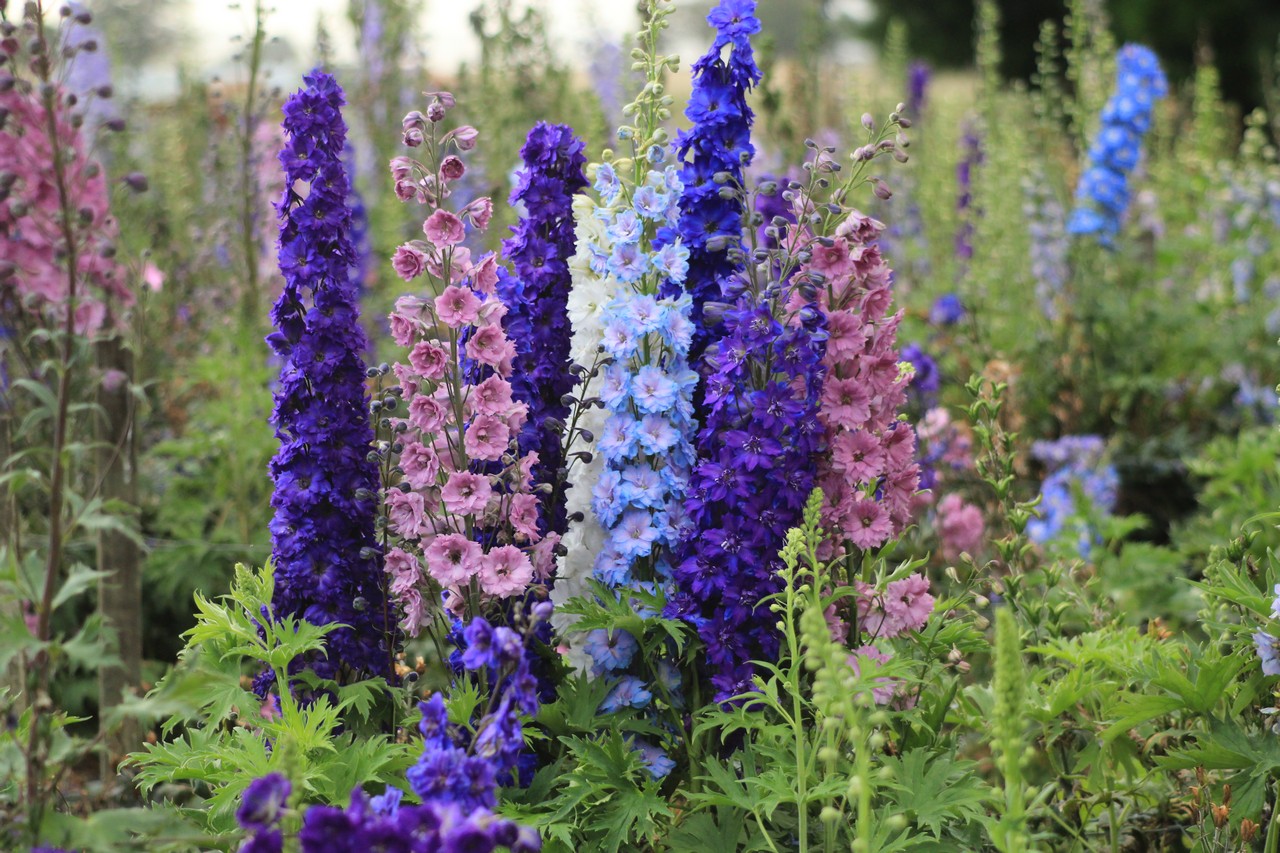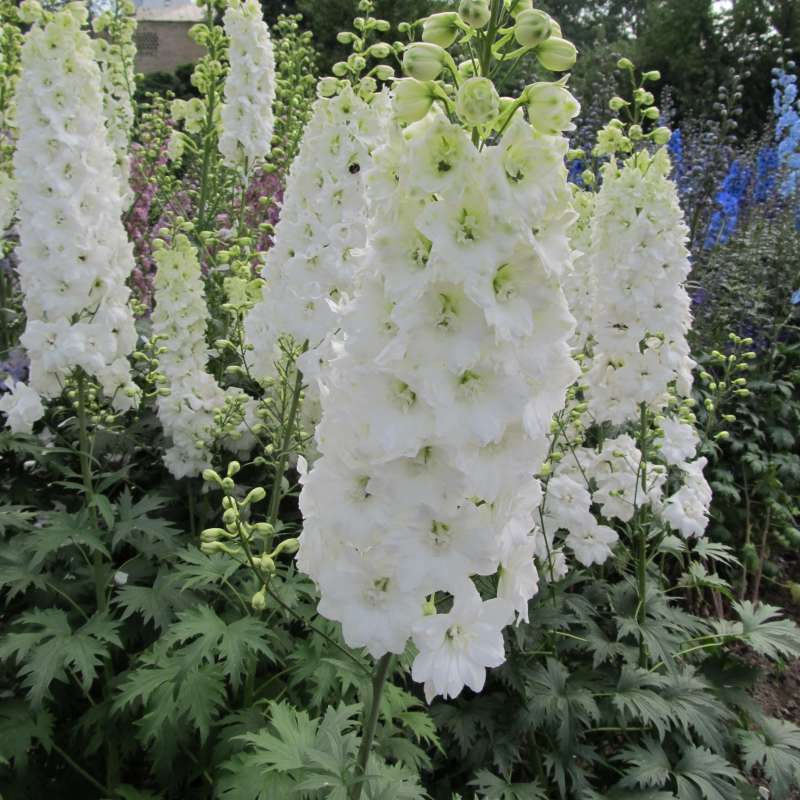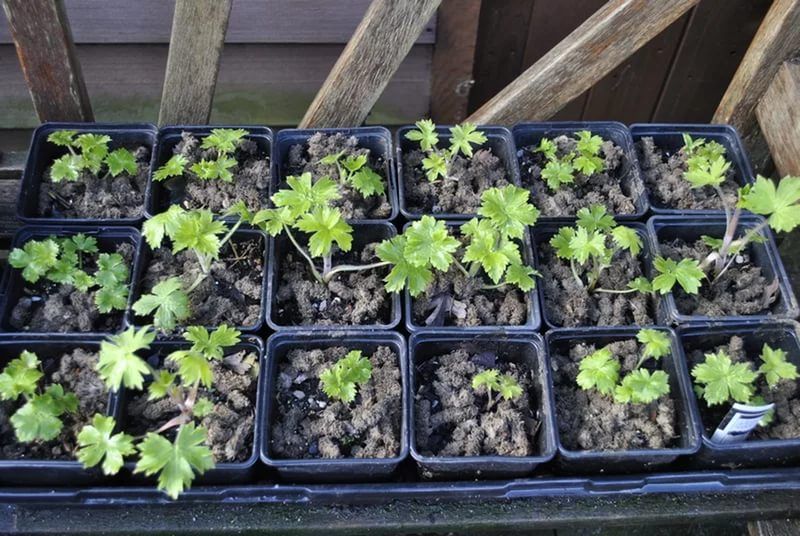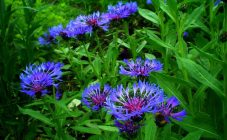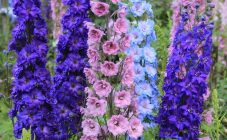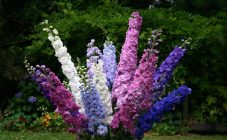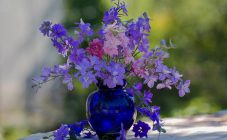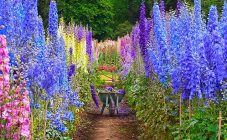Content:
The perennial delphinium flower is very popular among gardeners, it is especially often used in group plantings. But not only for its attractive appearance, they love this plant, since it can be very successfully and originally used in landscape design, creating unique compositions. This culture is distinguished by its unpretentiousness and great variety.
Description
Delphinium (delphinium) is an unusually beautiful plant that belongs to the Buttercup family. The culture is distinguished by a rather powerful peduncle, there are many inflorescences on it. They are collected in the form of a pyramid. Inside each flower are several petals that are darker in color than the rest.
The name of the plant comes from the Greek word delphinos, which means dolphin. This is not surprising, since the flower buds of the culture are very similar in shape to these particular animals.
In Russia, you can very often find another name for this plant - larkspur and spur. This name was given to the delphinium for the special appearance of the upper sepal. In total, about 100 varieties are known in Russia. Delphinium is also popular among gardeners in Asia, Europe, and North America. Very often you can find a field or wild delphinium that grows in open fields. It is a little smaller than the garden one, but still beautiful and attractive.
Outwardly, the wild delphinium, like most other representatives, is a tall bush up to 2 m tall, with bright large inflorescences located on several branches.
The plant perfectly tolerates drought, is frost-resistant and does not require complex procedures when organizing care. If, after the first flowering, dry inflorescences are removed, then by the end of the season the flowers will appear again.
The plant can be an annual (it is often used for interior decoration, for example, the varieties Hyacinth, Ajax, Ajax Larkspur) or a perennial, which is successfully grown in many gardens. Some varieties can only be grown at home, such as King Arthur. The plant begins to bloom in June. Flowering can last up to 50 days, then the foliage turns yellow and dies off.
Beneficial features
In folk medicine, this plant has been used for a very long time. It is often used in the treatment of migraine, conjunctivitis, skin diseases, pleurisy, pneumonia. The hemostatic properties of this culture are also well known. Some species of this plant have the most beneficial properties. For example, delphinium Staphysagria is used in homeopathy. It is most often used in the treatment of skin and nervous diseases.
In pharmacology, the herb of this plant and seeds are used. The latter are harvested during flowering. During harvesting, the seeds should not become coarse.
From the history
There are many legends and stories about the origin of the name of this plant. According to an ancient legend, this flower was so named by the Greeks in honor of a young sculptor who was turned into a dolphin by the ancient gods.He made a statue of his girlfriend and revived it afterwards. After divine forces punished him, the dolphin sailed to his girlfriend and presented her with this flower.
The delphinium came to the territory of Russia and Europe from Eastern Siberia, the Far East and Transbaikalia. Botanist Johann Gmelin was first struck by the beauty of this plant in 1735. He collected seeds from the culture he liked and brought them to the botanical garden of St. Petersburg. In 1741, the plant came to England, then the delphinium spread to European countries.
Variety of species and varieties
The delphinium was originally grown on the basis of two main types:
- Delphinium is giant;
- Delphinium large-flowered (distinguished by large flowers).
Subsequently, breeders have bred various hybrids of this culture. Today, many varieties of plants of this type can be distinguished, all of them can be divided into several main groups:
- Marfinsky hybrids. These are quite impressive plants, the growth of which reaches 1.7-2 m. Such representatives stand out strongly for their powerful strong appearance with bright dense semi-double flowers. A feature of such hybrids is the preservation of parental properties by 80-90%. This group includes the Blue Lace delphinium variety.
- Delphinium Belladonna. The original representative of this plant, which has a drooping appearance of panicle-shaped inflorescences. Among gardeners, the Casablanca variety is the most popular.
- Delphinium Elatum is bred from the group of tall perennials. The plant stands out in that each of the representatives has similar shades, ranging from pale blue (almost transparent) to rich purple flowers. The Tuman variety can be considered a striking representative.
- Pacific flowers or pacific delphiniums are distinguished by their high growth. They are just giants. They also have dense, large inflorescences.
- Scottish delphiniums. This is a group of hybrid delphiniums that stand out in super double flowers. Differs in bright inflorescences of various colors. Such a hybrid can have up to 58 petals on one flower. The height reaches up to 120 cm. They are durable, hardy, and when sowed by seed, retain their parental properties well. Flamenco delphinium, sweet sensation, Highlander Flamenco, sweethearts, Crystal Delight, moonlight can be considered a striking representative of this group.
- Low-growing perennial delphiniums. This group unites flowers of short stature (up to 1 m). It is very often grown by florists who make beautiful compositions with them.
The best varieties
The most prominent representatives should still be highlighted:
- Delphinium blue. A relatively low plant variety that has blue flowers with a darker core. It is quite a heat-loving plant that will not survive the winter outdoors. Therefore, in the fall, it is transferred indoors. Very often it is called delphinium blue.
- Delphinium is white. A beautiful tall plant up to 2 meters tall, with beautiful white flowers.
- Delphinium pink. Beautiful bushes that have a bright pink color, double flowers. Every gardener dreams of growing such a beauty.
- Delphinium red refers to upright plants, up to 2 m high. Flowers are bright red. The plant does not tolerate cold winters, so it is better to remove it indoors for the winter.
- Delphinium Galahad is an ideal solution for gardens in colder areas, as it tolerates winter well. Flowers are double and semi-double, up to 7 cm in diameter.
- Delphinium Astolat is an unusually beautiful plant that stands out for its bright crimson flowers, with a darker brown core.
- Delphinium Bolero belongs to the Highlander series. It is represented by plants of medium height with lush white flowers.
- Delphinium Black Knight. An excellent variety for cutting, has double flowers in bright purple color. The central part of the plant is almost black.
- Delphinium Alyax. The most common delphinium mix, which will delight you with a variety of colors and a beautiful appearance.
- Delphinium Aurora. A snow-white viable representative, which is distinguished by a large number of inflorescences on a branch and excellent preservation rates in a cut form.
Landing features
Most often, the perennial delphinium is placed in the center of the flower bed or along the fence. In landscape design, specialists are able to create unique compositions by combining different types, as well as using other plants.
To obtain abundant flowering, the plant should be planted in areas that are lighted and protected from the wind. It is not necessary to place the culture in sunny places, it is better to organize shading. One of the main landing conditions is the mineralization of the landing pit. Most of all, the culture loves sandy loam or loamy soil of moderate moisture. It must be rich in humus. If the soil is highly acidic, then liming will be required. After the hole is dug (the hole is dug with a diameter of 40 cm and a depth of 50 cm), compost, ash and humus are introduced into it. You should also add a complex mineral fertilizer. Before planting, the roots of the plant are well moistened, it is better to leave it in water for a while. This will help the culture to take root and take root faster.
It is unacceptable to deepen the plant. The root collar should be level with the ground.
Reproduction of a delphinium can be carried out using seeds, cuttings or dividing the bush. For perennial crops, propagation by cuttings and division is most acceptable. Annual varieties are more often sown with seeds, rather than perennials. First, the culture is sown on seedlings in March-April, and then planted in a permanent place.
Growing
Caring for a plant of this type is quite simple. It consists in performing simple actions:
- fertilization;
- weeding;
- trimming;
- installation of supports.
Watering
Delphinium loves moderate moisture intake, but not excessive moisture. With high dampness, the bushes grow poorly. Watering is required in moderation, especially during dry periods. A single watering done at the very root will be enough.
Fertilization
The first feeding is carried out in early spring, when the shoots of a young plant reach a height of 10-20 cm. For such purposes, complex mineral compositions are used. If the bushes are very thickened, then thinning is carried out.Weak and diseased branches are removed. From beautiful shoots, you can choose some for reproduction. A maximum of 7 shoots remain in the bush. The second feeding is carried out before flowering.
Preparing for winter
After flowering, the plant is cut off, leaving hemp 15 cm high. Then the hollow holes of the stems are filled with plasticine or clay so that moisture does not get inside. Some types of flowers must be dug up and taken into the house, otherwise they will not survive the winter. For some varieties, it is enough just to cover the plantings with spruce branches or dry foliage (delphinium Pink Punch, Franks, Pacific). There are more frost-resistant varieties that endure the winter even without additional insulation (yellow delphinium, Guardiant, Bluebird, White Swan).
Pests and diseases
Among the diseases of the plant, one should highlight:
- powdery mildew;
- rust;
- rotten root collar;
- smut;
- withering.
When growing delphiniums, you can meet with mosaics, viral diseases, spider mites, onion fly and other flower diseases. When the first signs appear, it is imperative to treat the bushes with special compounds, today they are sold in large quantities on the shelves of flower shops.
To reduce the development of pathogenic bacteria in the soil, which can provoke the emergence of most diseases, it is recommended to water the soil with special biological products in the spring along with top dressing: trichodermine or haupsin.
Whichever delphinium variety is chosen: Chinese, yellow, White, Red Giant, Crystal Fountain or Butterfly, or any mixture, you can get a beautiful abundant flowering. The main thing is to properly care for the plant, providing it with the proper conditions.
